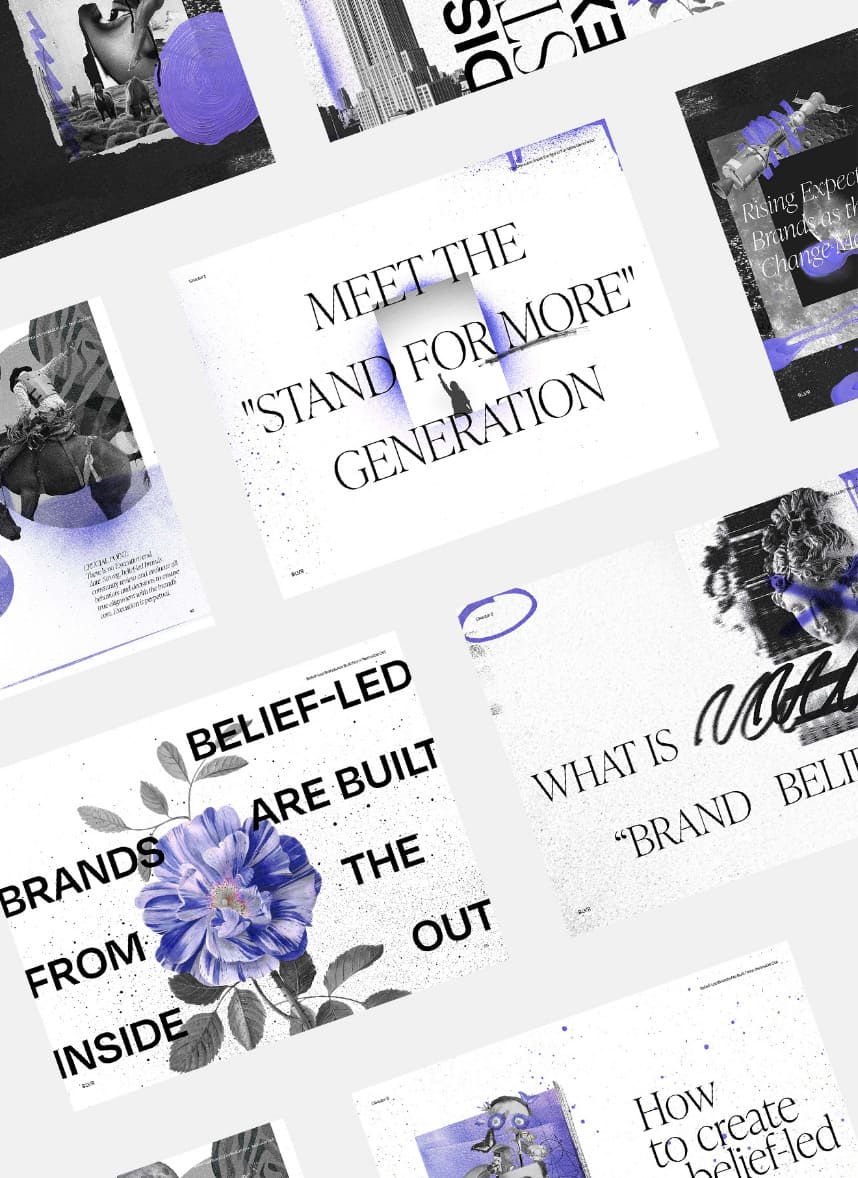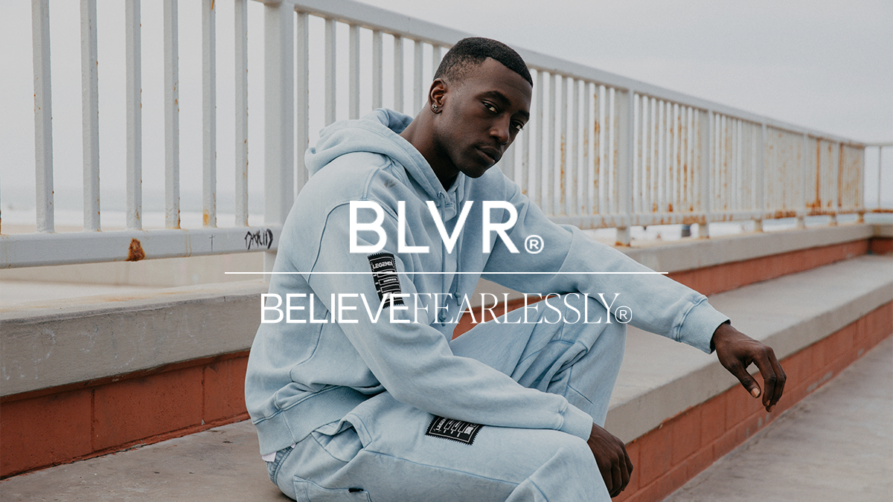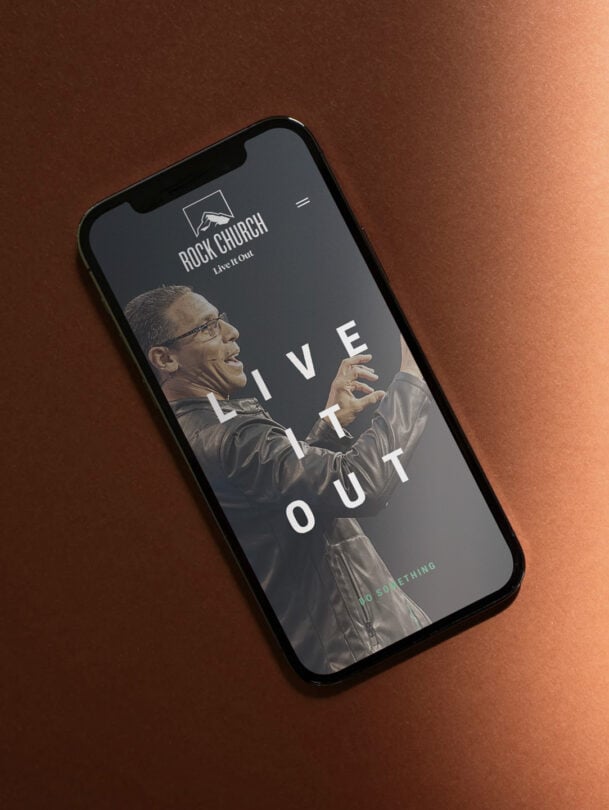The Long-Term Benefits of Church Rebranding
Articles
October 21, 2022
This article explores the newest brand-building strategy: Belief-led brand transformation. This revolutionary concept goes beyond a standard rebranding project to create a resilient brand legacy that provides differentiation, growth, and impact opportunities. Read on to understand what’s behind the most significant shifts in consumer sentiment in our lifetime. Find out the data-backed benefits of leading with conviction, and learn the actionable framework to uncover the core belief that will transform your organization into an impactful powerhouse with unparalleled staying power.
Introduction
Maybe you’re feeling the recession crunch and thinking about different brand-building strategies. Perhaps you’re launching a new product, or a recent merger has shaken your identity and left your employees disoriented.
Or maybe, like many executives, you’ve noticed the shifting consumer behaviors–and how these big changes are leaving your business and profits behind.
You’re not alone. While Millennials have eclipsed Baby Boomers as the largest group of consumers in the U.S., they’re bringing major market disruptors– and a host of new demands for brands.
Chief among these shifting priorities is a groundbreaking concept revolutionizing how brands connect with consumers. It’s called belief-led brand transformation.
Through it, organizations experience 3x faster growth, inspire 261% more loyalty in customers, and enjoy 30% more innovation among employees–all while delivering long-term positive benefits to the world.
In this changing global landscape, undertaking a standard rebranding project isn’t enough to stay relevant. To attract loyal customers, inspire meaningful growth, and create a lasting, fulfilling legacy, there is only one clear way forward: belief-led transformation.
The old way of brand building – product features & benefits
In the past, organizations downplayed the importance of branding by simply viewing it as a marketing tactic. Brand awareness, brand loyalty, and company value were driven by positioning on the lowest common denominator – product features and benefits. Features describe the attributes that make a brand different, while benefits describe why the attribute matters and how it is helpful to the target audience.
While features and benefits have their place in the purchase decision-making cycle, it is difficult to build a brand from features and benefits alone. Competitors can easily copy them, reducing an organization’s competitive advantage.
The current way of brand building – emotions and social values
As branding evolved, marketers embraced the idea that brands are bought based on feelings and then rationalized with facts. Brand positioning strategies moved from the table stakes of features and benefits to new territories full of emotional connection.
Brands invested in understanding the deeper purpose behind consumer behaviors and built empathetic brand stories that celebrated the feelings consumers hold true.
But this style of branding was designed to leave the consumer with a certain impression of an organization, while the business may have been run in a contradictory manner. It doesn’t sit well with today’s educated, curious, civically minded consumers who know that brands today need to stand for more.
Changing audience segmentation: Meet the Stand For More generation
A new audience segment dubbed the Stand For More generation is redefining the playbook for brand building. This group, made up of Millennials and Gen Z, are the most ethical and socially conscious generation of our time, and they want brands to know it.
The Stand For More audience will validate a brand’s authenticity by reviewing the company’s larger actions–the social stance they take, the experience they give customers, how they treat its employees, the products or services they bring to market, and most importantly, the larger impact they make on the world.
For many brands, these things are not aligned, resulting in a lack of authenticity and trust. In fact, research shows brand trust is at an all-time low. And when your customers don’t trust you, they start looking for brands they can.
The Stand For More generation want more than a product benefit; they want a belief system
The Stand For More generation wants more than a product benefit; they want a belief system. And they want it to match their values.
As more organizations pivot to a belief-led model, they are embracing the idea that having a brand isn’t a marketing tactic; it’s a revolutionary shift in the way of doing business.
It is a method to transform from the inside out. This means rather than beginning with what it is that a company sells, brands should begin with what a company believes about the world.
The central belief becomes the foundation of every decision, interaction, and action. It delivers strategic alignment so that all elements of the business, from the marketing strategy to the way a company behaves, is aligned in the best way to support what the brand believes.
New purchase decision frameworks:
We believe. Therefore we buy.
Today’s consumers expect organizations to stand for more than just profit. The Stand For More generation increasingly experience brands as extensions of their own identities and support organizations that reflect their deep personal values and beliefs.
For example, a consumer may believe:
- Everybody is an athlete.
- It’s the responsibility of humans to protect the environment.
- Travel is best when you live like a local.
- Healthy food can also be delicious.
When making purchases, today’s consumers choose brands that reflect those deeply held personal beliefs. Someone who believes that travel is best when you live like a local will likely book a home in a residential neighborhood instead of staying in a downtown luxury hotel.
On the reverse side, consumers reject and pass over brands that:
- Oppose or violate their deeply-held value standards.
- Don’t have any clearly defined beliefs at all.
- Act hypocritically, stating one set of beliefs publicly but then behaving the opposite way when their reputation or profit is at stake.
The new way of brand building: Belief-led brands are the future
Traditional branding and marketing strategies alone are ineffective with today’s consumers because they look beyond colors and frills and into the beating heart of an organization.
Sure, creating a visual identity, a mission statement, and a catchy slogan is certainly important, but won’t have any traction with consumers if they’re not bolstered by one single, powerful… a brand’s belief.
A brand belief is a deeply held conviction that serves as a guiding principle for every brand behavior, decision, and interaction. When used properly, brand belief can be the catalyst to connect your brand’s efforts to the bottom line and beyond. A brands belief can be:
- A tool to drive long-term growth.
- A guide for strategic focus and a guardrail for decision-making.
- A pivotal differentiator to defend against category disruptors.
- A way to build loyalists or find new audience segments.
- A north star to drive product innovation.
- A way to attract top talent.
- A tool to unite a workforce and drive productivity & performance.
- A guide to driving the greatest social impact.
Introducing Belief-Led Brand Transformation
As we’ve learnt, transforming your business doesn’t begin with a logo or updating the website.
Successful belief-led brand transformation that results in true impact and ROI has to be built from the inside out.
This means rather than beginning with what you sell, you should begin with what you believe about the world. In other words, start with identifying/articulating your brand belief and then look at the business implications.
At BLVR®, we’ve used our Belief-Led Transformation Method to transform hundreds of brands. It may sound difficult, but as it turns out, only these four steps are needed to build belief-led brand transformation:
01.
Belief:
Uncover the belief at the heart of an organization.
02.
Purpose:
Translate that into an authentic purpose to drive the business forward.
03.
Vision:
Define the future you’ll create.
04.
Behavior:
Activate the belief through every behavior.
How to create a belief led brand:
Learn why belief-led brands inspire customer loyalty and bring a positive impact. Get actionable insights and frameworks.

What are the four steps of Belief-Led Brand Transformation?
Step 1: Belief
What is a brand belief?
A brand belief is what a brand believes to be true about the world. Put simply, brand belief is uncovering the Brand’s unwavering core.
The earth and all of its inhabitants deserve respect (National Geographic). Beauty is for everyone (Dove). Businesses have a responsibility to use their resources to protect the earth (Patagonia).
A brand’s Belief should be the heart of every single decision, behavior, and interaction undertaken by an organization.
– Jasmine Bina
As Bina’s quote above calls out, Belief is quickly replacing products, features, and benefits as a brand’s unique selling proposition (USP). When consumers support a belief-led brand, they’re not just buying things. They’re buying a code of ethics, a shared conviction, and a badge of personal identity.
Belief is more powerful than benefit. It taps into a consumer’s most fundamental values and behaviors. Those who agree with a brand’s belief become loyal converts and ambassadors.
Where does brand belief originate?
Consumers expect belief to radiate from an organization’s highest leadership. In some cases, beliefs stem from a founder’s life-changing experience, such as witnessing intense poverty and shoeless children firsthand (TOMS) or freeing a sea turtle caught in a fishing net (Keiko Conservation).
Other times, belief might come not from a single moment of enlightenment but from a collection of meaningful experiences that have contributed to a deep conviction about the world. For example, someone already working to fight climate change founding a meat substitute brand (Beyond Meat).
Regardless of where the original inspiration came from, consumers expect belief to radiate from an organization’s highest leadership. In fact, 81% of consumers agree that an organization’s CEO, founder, or owner is “the most responsible” for setting the tone and communicating the values of a brand.
The same survey uncovered that over three-quarters of consumers expect an organization’s leader to embody the mission or purpose in their personal life.
Consumers expect the CEO of an environmentally based company to have socials full of kayaking and rock climbing photos and the Founder of an organic food company not to eat cheese fries for every meal.
However, a brand’s belief shouldn’t stop at the top levels. Belief-led branding guides the entire end-to-end experience, not just the marketing department.
From internal culture, customer experience, and product development through marketing, comms, and social impact only work when sponsored by leadership and pushed down throughout the business.
Is a brand’s belief constant?
Brand belief is permanent. Period. Unshaken by disagreeing consumer reactions, media criticism, or outsider opinion, a successful belief-led organization sticks to its convictions–even if it means losing money or customers along the way.
Unlike an organization’s actions, purpose, or mission, the core brand belief never changes.
Every marketer knows a product’s target audience can’t be “everyone.” Similarly, not every brand’s belief resonates with every consumer.
While some people avidly support the cause, others actively hate the belief and disagree loudly (consider Chick-fil-A and the world’s most divisive chicken sandwich).
How organizations handle their true brand beliefs—even in the face of adversity—defines their likelihood of success. For now, remember that because beliefs are constant, belief-led organizations are formed from the inside out.
When an organization’s behavior is truly aligned with its core, beliefs permeate every action, decision, and behavior from the ground up. For adherents, there is no option but to reinforce the core belief every moment of every day.
Step 2: Purpose
What is brand purpose?
A brand’s purpose is what it intends to do about its belief. It ignites your reason for being. The purpose is the active manifestation of the brand belief, that is, a description of the brand’s main function.
A brand’s Purpose typically begins with an action verb, such as:
- Build
- Create
- Empower
- Inspire
- Share
- Supply
True brand purpose exists only when it’s built on the foundation of solid brand belief. Purpose would be meaningless without the core conviction to back it up.
It’s crucial to note that a brand’s Purpose in this sense is never “making money” and is never product-focused. Profit is an outcome of an aligned Purpose but is never the sole intention of a belief-led brand.
Is brand purpose the same as brand belief?
We explore this question more in this article. But to summarise the thinking: It is often confused or used interchangeably, but there’s a big difference between “belief” and “purpose” when it comes to brands.
In the simplest terms:
- Belief: What a brand believes to be true about the world
- Purpose: What the brand intends to do about it
While different, both Belief and Purpose are essential for today’s brands and businesses. Additionally, notice: neither Belief nor Purpose makes any mention of products, services, or business goals.
Let’s take a look at some examples:
NATIONAL GEOGRAPHIC
- Belief: The earth and all of its inhabitants deserve respect
- Purpose: To explore and protect our planet
NATIONAL GEOGRAPHIC
- Belief: The earth and all of its inhabitants deserve respect
- Purpose: To explore and protect our planet
DOVE
- Belief: Everyone is beautiful
- Purpose: To help women and girls realize their full potential
PATAGONIA
- Belief: Businesses have a responsibility to use their resources to protect the earth
- Purpose: To save our home planet
Step 3: Vision
What is a brand vision?
A brand vision statement defines what the world looks like once a brand has achieved its purpose. Essentially it is the future objectives of the organization. As a part of a brand’s strategy, the brand vision is a key part of the framework that executives use to not only clearly specify the brand’s DNA but also justify the impact the brand will make for the organization and the world at large.
It is often a one-sentence statement describing the clear and inspirational long-term desired end-state. It is a look into the future of where a company and brand wants to go. A brand’s vision is designed to improve or change the world in one way or another. A vision statement is often big and bold but also accessible.
Before a vision can be established, a company must know what it believes and why it exists (purpose). Let’s relook at our example to see how vision plays into brand transformation:
NATIONAL GEOGRAPHIC
- Belief: The earth and all of its inhabitants deserve respect
- Purpose: To explore and protect our planet
- Vision: Illuminate and protect the wonder of our world
DOVE
- Belief: Everyone is beautiful
- Purpose: To help women and girls realize their full potential
- Vision: To see beauty as a source of confidence, not anxiety
PATAGONIA
- Belief: Businesses have a responsibility to use their resources to protect the earth
- Purpose: To save our home planet
- Vision: Use all our resources to protect life on earth
Clarity of vision is critical because it reveals a common goal and direction for a company’s employees. A compelling vision is infused with passion, making it inspiring and aligning it with your business’s values and goals.
Step 4: Behavior
What is brand behavior?
A brand’s behavior is the Belief in Motion. It is the big and small ways a brand lives out its Belief and Purpose every day.
The final element of transforming brands from the inside out, Behavior, is the immense collection of actions through which Belief, Purpose, and vision shine. These critical behaviors demonstrate a true commitment to consumers and the world at large.
Essential behaviors exist across every aspect of an organization, including:
- Customer experience
- Product development
- Service development
- Sales & marketing
- Employee experience
- Social good
Why do consumers pay attention to brand behaviors?
Organizations that don’t act according to consumer expectations are often publicly punished. About half of today’s consumers walk away from brands when disappointed by a brand’s words or actions on a social issue. Many never come back.
It may sound extreme, but such negative reactions make sense. After all, today’s consumers and employees use brands to express their identity and outwardly display deeply-held values. Inauthentic brand behavior goes beyond just disappointing consumers. It stirs up deep feelings of anger, betrayal, and potentially even personal identity conflicts.
Brands that don’t define and live out their convictions often find themselves a target for consumer outrage. At a time when 64% of consumers buy or boycott a brand solely because of its position on a social or political issue, your business can quickly find itself in hot water if you don’t have a strong belief to guide you forward.
So, what does this mean for your organization today? Simply this: No new logo design or brand personality will ever make up for a nonexistent core belief. If you want to create a long-lasting brand that attracts loyal customers and thrives through ever-changing times, look beyond a traditional rebrand.
Brand building know-how: what does it take to build a belief-led brand?
Belief-led brand transformation doesn’t just spontaneously happen. They also don’t evolve naturally from existing businesses without deliberate care and attention. True belief-led brand transformation occurs only after painstaking reflection, fearless decisions, and courageous alignment, and the will to act.
Thankfully, an established methodology exists for transitioning brands into belief-led world changers. Developed by BLVR®, a global brand innovation company, this three-phased approach helps executive leadership teams discover their brand’s true belief and live it out at every scale.
You can explore more about these brand-building strategies and why brand consistency is key here.
How to create a belief led brand:
Learn why belief-led brands inspire customer loyalty and bring a positive impact. Get actionable insights and frameworks.

BELIEF-LED BRAND TRANSFORMATION DELIVERS ROI
Revolutionary brand building is difficult, sometimes painful, work. It requires fearless humility and an open mind. As with many challenges, the outcome of belief-led brand transformation is more than worth the hard work.
Belief Drives Brand Awareness – “78% [of consumers] were more likely to remember an organization with a strong purpose.” (Source)
Belief Drives Brand Trust – “When a brand has a strong Purpose, consumers were 4.1x more likely to trust the brand.” (Source)
Belief Drives Conversion – “2/3 [of consumers] said they’d consider the organization’s purpose when deciding what to buy.” (Source)
Belief Drives Brand Loyalty – “72% also said that they’d be more likely to forgive [a belief-led] organization if it made a mistake.” (Source)
Belief Drives Business Growth – “Unilever’s 28 “sustainable living” brands…delivered 75% of the organization’s growth and grew 69% faster on average than the rest of its businesses in 2018.” (Source)
Belief Drives Innovation – “Authentic, employee-driven innovation may be one of the most valuable outcomes that a purpose-driven culture can trigger.” (Source)
Belief Drives Hiring & Retention –”[Belief-led] organizations report 40% higher levels of workforce retention than their competitors.” (Source)
Conclusion
The data is clear. Belief-led brands provide incredible opportunities for growth, innovation, and creating stronger, more deeply resonating bonds with customers, employees, and our world.
The consumer world is changing. The time to act is now. Organizations hoping to create resilient legacy brands built on a strong foundation of loyal customers and employees must push beyond products, features, and benefits.
It’s time to grow toward something greater. It’s time for Belief-Led Brand Transformation.
WOULD YOU LIKE TO LEARN MORE?
Be sure to check out more thought leadership in our belief-led transformation series.
About the author(s)
01
More
© BLVR
SD / CA





